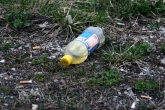‘No perfect way to measure litter’ as Defra creates stats dashboard
Almost 12,000 incidents of littering were reported through mobile apps in 2016/17, according to a new publication by the Department for Environment, Food and Rural Affairs (Defra) which seeks to highlight the different ways to measure and recognise litter throughout England.
 Other stats highlighted by the department show that 88 per cent of places in England meet the acceptable standard for litter and that it costs £29 per household to keep streets clean.
Other stats highlighted by the department show that 88 per cent of places in England meet the acceptable standard for litter and that it costs £29 per household to keep streets clean.
Noting that ‘there’s no one perfect way to measure litter’, Defra has collected data to reveal the current state of the nation regarding litter and littering, as well as how the government is keeping up with the aims of its Litter Strategy, launched in April 2017.
Developed by the Litter Strategy Working Group for Data and Monitoring, the litter ‘dashboard’ presents five key indicators to assess and monitor litter in the UK by ‘looking at litter from different angles’ – not just the amount of litter, which is necessarily hard to quantify, but also the public’s behaviour and attitude towards it.
The dashboard provides information across five sections:
- Litter on the ground, including beach litter;
- Public perception of litter;
- Cleanliness of public places;
- Getting people involved, and
- The cost of keeping the streets clean
The figures, which relate to the period April 2016 to March 2017, have been collated from various sources, including surveys from the Marine Conservation Society’s Great British Beach Clean and data from an app called ‘Love Clean Streets’, through which people can report incidents of litter to the authorities.
The Litter Strategy committed the government to promoting the use of such reporting apps, though the page does acknowledge the limitations of this data as only around 3,800 people used Love Clean Streets in 2016-17, and those were mostly in urban areas.

The public perception of litter is also presented, using data collected via the Crime Survey for England and Wales, which reveals that 30 per cent of people feel there is a ‘very or fairly big’ problem with litter and rubbish in their area.
However, it is also claimed on the dashboard that 88 per cent of places meet the acceptable standard for litter. This standard is set out in the government’s statutory ‘Code of practice on litter and refuse’, which states that any site reaching grade B (‘predominantly free of litter apart from some small items’) is classed as ‘acceptable’. Defra has used data self-submitted by 32 local authorities to the Association of Public Service Excellence (APSE), along with a supplementary survey of 12 further authorities.
In terms of cost, Defra has settled on a figure of £29 per household per year (£682 million total) to keep the streets clean, a figure arrived at from the Office of National Statistics and covering street cleaning, emptying bins and removing fly-tipped waste.
The dashboard will be updated year on year to make use of continually changing data from the sources and surveys utilised in this iteration, helping Defra to inform policy development and assess progress over time.
The government’s Litter Strategy for England, published in April 2017, was generally well-received by the waste and packaging industry, with proposals to build an ‘anti-litter culture’ including increasing fines for litterers up to £150, creating a Litter Innovation Fund to finance research projects and developing a national anti-littering campaign, said to be launched sometime this year.
In January, the long-awaited 25 Year Environment Plan was also revealed, with further promises to deal with the litter problem and reiterations of the plan for a national campaign, although more detail about this has yet to materialise.








